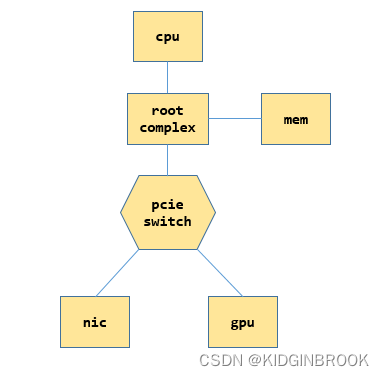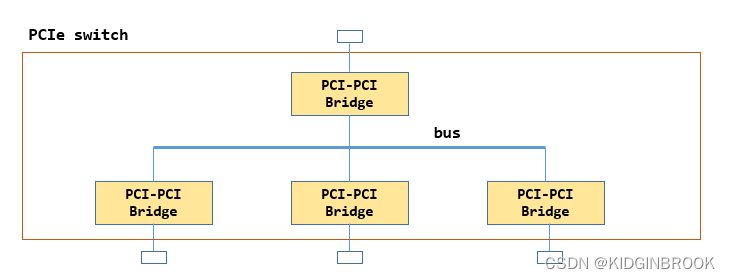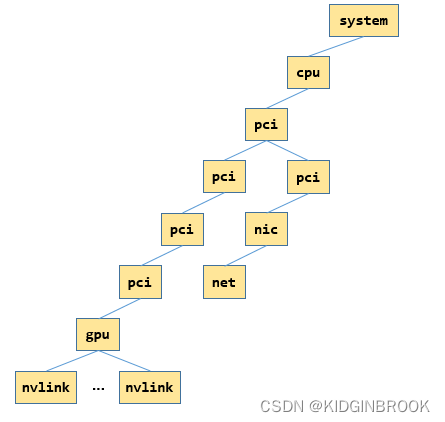作者|KIDGINBROOK
更新|潘丽晨
上节介绍所有节点执行了bootstrap网络连接的建立,接下来介绍下拓扑分析。
由于 GPU 机器架构是多种多样的,一台机器上可能有多个网卡,多个 GPU 卡,卡间连接也各不相同,因此需要对机器内设备连接拓扑进行分析,以使性能在各种拓扑结构下都尽可能好。
接着上回继续看 initTransportsRank。
static ncclResult_t initTransportsRank(struct ncclComm* comm, ncclUniqueId* commId) { // We use 3 AllGathers // 1. { peerInfo, comm } // 2. ConnectTransport[nranks], ConnectValue[nranks] // 3. { nThreads, nrings, compCap, prev[MAXCHANNELS], next[MAXCHANNELS] } int rank = comm->rank; int nranks = comm->nRanks; uint64_t commHash = getHash(commId->internal, NCCL_UNIQUE_ID_BYTES); TRACE(NCCL_INIT, "comm %p, commHash %lx, rank %d nranks %d - BEGIN", comm, commHash, rank, nranks); NCCLCHECK(bootstrapInit(commId, rank, nranks, &comm->bootstrap)); // AllGather1 - begin struct { struct ncclPeerInfo peerInfo; struct ncclComm* comm; } *allGather1Data; NCCLCHECK(ncclCalloc(&allGather1Data, nranks)); allGather1Data[rank].comm = comm; struct ncclPeerInfo* myInfo = &allGather1Data[rank].peerInfo; NCCLCHECK(fillInfo(comm, myInfo, commHash)); ...}
复制代码
创建 nrank 个 allGather1Data,然后通过 fillInfo 填充当前 rank 的 peerInfo,ncclPeerInfo 是 rank 的一些基本信息,比如 rank 号,在哪个机器的哪个进程等。
struct ncclPeerInfo { int rank; int cudaDev; int gdrSupport; uint64_t hostHash; uint64_t pidHash; dev_t shmDev; int64_t busId;}; static ncclResult_t fillInfo(struct ncclComm* comm, struct ncclPeerInfo* info, uint64_t commHash) { info->rank = comm->rank; CUDACHECK(cudaGetDevice(&info->cudaDev)); info->hostHash=getHostHash()+commHash; info->pidHash=getPidHash()+commHash; // Get the device MAJOR:MINOR of /dev/shm so we can use that // information to decide whether we can use SHM for inter-process // communication in a container environment struct stat statbuf; SYSCHECK(stat("/dev/shm", &statbuf), "stat"); info->shmDev = statbuf.st_dev; info->busId = comm->busId; NCCLCHECK(ncclGpuGdrSupport(&info->gdrSupport)); return ncclSuccess;}
复制代码
获取当前卡的 rank,PCIe busId,/dev/shm 的设备号,填充到 ncclPeerInfo,然后通过 ncclGpuGdrSupport 查看是否支持 gdr,rdma 在通信前需要注册一段内存,使得网卡知道虚拟地址和物理地址的映射,但是如果每次通信都需要将 data 从显存拷贝到内存再通信的话效率就比较低。
而 IB 提供了 peer memory 的接口,使得 ib 网卡可以访问其他 PCIe 空间,nv 基于 peer memory 实现了自己的驱动,使得 rdma 可以直接注册显存,这样通信就可以避免 host 和 device 的内存拷贝,IB 可以直接 dma 显存,即 gdr。
static ncclResult_t ncclGpuGdrSupport(int* gdrSupport) { int netDevs; NCCLCHECK(ncclNetDevices(&netDevs)); *gdrSupport = 0; for (int dev=0; dev<netDevs; dev++) { // Find a net device which is GDR-capable ncclNetProperties_t props; NCCLCHECK(ncclNet->getProperties(dev, &props)); if ((props.ptrSupport & NCCL_PTR_CUDA) == 0) continue; // Allocate memory on the GPU and try to register it on the NIC. void *lComm = NULL, *sComm = NULL, *rComm = NULL; ncclNetHandle_t handle; void* gpuPtr = NULL; void* mHandle = NULL; NCCLCHECK(ncclNetListen(dev, &handle, &lComm)); NCCLCHECK(ncclNetConnect(dev, &handle, &sComm)); NCCLCHECK(ncclNetAccept(lComm, &rComm)); CUDACHECK(cudaMalloc(&gpuPtr, GPU_BUF_SIZE)); ncclDebugNoWarn = NCCL_NET; if (ncclNetRegMr(sComm, gpuPtr, GPU_BUF_SIZE, NCCL_PTR_CUDA, &mHandle) == ncclSuccess) { NCCLCHECK(ncclNetDeregMr(sComm, mHandle)); NCCLCHECK(ncclNetRegMr(rComm, gpuPtr, GPU_BUF_SIZE, NCCL_PTR_CUDA, &mHandle)); NCCLCHECK(ncclNetDeregMr(rComm, mHandle)); *gdrSupport = 1; } ncclDebugNoWarn = 0; CUDACHECK(cudaFree(gpuPtr)); NCCLCHECK(ncclNetCloseRecv(rComm)); NCCLCHECK(ncclNetCloseSend(sComm)); NCCLCHECK(ncclNetCloseListen(lComm)); break; } return ncclSuccess;}
复制代码
这里会遍历每一个网卡,获取网卡的信息,由第一节可以知道这里的 ncclNet 就是 ncclNetIb。
ncclResult_t ncclIbGdrSupport(int ibDev) { static int moduleLoaded = -1; if (moduleLoaded == -1) { moduleLoaded = (access("/sys/kernel/mm/memory_peers/nv_mem/version", F_OK) == -1) ? 0 : 1; } if (moduleLoaded == 0) return ncclSystemError; return ncclSuccess;} ncclResult_t ncclIbGetProperties(int dev, ncclNetProperties_t* props) { props->name = ncclIbDevs[dev].devName; props->pciPath = ncclIbDevs[dev].pciPath; props->guid = ncclIbDevs[dev].guid; props->ptrSupport = NCCL_PTR_HOST; if (ncclIbGdrSupport(dev) != ncclSuccess) { INFO(NCCL_NET,"NET/IB : GPU Direct RDMA Disabled for HCA %d '%s' (no module)", dev, ncclIbDevs[dev].devName); } else { props->ptrSupport |= NCCL_PTR_CUDA; } props->speed = ncclIbDevs[dev].speed; props->port = ncclIbDevs[dev].port + ncclIbDevs[dev].realPort; props->maxComms = ncclIbDevs[dev].maxQp; return ncclSuccess;}
复制代码
这里主要是获取网卡名,PCIe 路径,guid 等信息,然后查看是否有/sys/kernel/mm/memory_peers/nv_mem/version 判断是否安装了 nv_peermem,即 nv 的驱动,如果安装了的话则设置 props->ptrSupport |= NCCL_PTR_CUDA,表示可以注册显存。
然后尝试注册显存,如果可以注册则设置 gdrSupport 为 1,这里其实会创建 rdma 连接,这个在后边会单独介绍,本次先略过。
static ncclResult_t initTransportsRank(struct ncclComm* comm, ncclUniqueId* commId) { ... NCCLCHECK(bootstrapAllGather(comm->bootstrap, allGather1Data, sizeof(*allGather1Data))); NCCLCHECK(ncclCalloc(&comm->peerInfo, nranks+1)); // Extra rank to represent CollNet root for (int i = 0; i < nranks; i++) { memcpy(comm->peerInfo+i, &allGather1Data[i].peerInfo, sizeof(struct ncclPeerInfo)); if ((i != rank) && (comm->peerInfo[i].hostHash == myInfo->hostHash) && (comm->peerInfo[i].busId == myInfo->busId)) { WARN("Duplicate GPU detected : rank %d and rank %d both on CUDA device %x", rank, i, myInfo->busId); return ncclInvalidUsage; } } // AllGather1 data is used again below // AllGather1 - end // Topo detection / System graph creation NCCLCHECK(ncclTopoGetSystem(comm, &comm->topo)); ...}
复制代码
然后 bootstrapAllGather 广播 allGather1Data,将获取到的其他节点 peerinfo 拷贝到 comm 里。
在看具体拓扑分析流程之前先简单了解一下 PCIe 的一些概念,一个简单的 PCIe 系统示例如下。
每个 CPU 都有自己的 root complex,后简称为 RC,RC 会帮助 cpu 和其他部分通信,比如和内存,和 PCIe 系统,当 cpu 发送过来一个物理地址之后,如果这个地址是在 PCIe 空间,会被 RC 转换成 PCIe 请求进行通信。
switch 的作用是扩展 PCIe 端口,下边可以连接设备或者其他 switch,上游来的请求被被他转发,PCIe 设备可以连在 RC,也可以连在 swtich,一个 switch 的内部如下所示。
内部有一个 PCIe 总线 ,然后通过多个 Bridge 扩展出多个端口,其中上边的那个称为上游端口,其他的叫做下游端口。
前文有提到 NCCL 中很常用的一个变量名叫 busId,比如 gpu 和 ib 网卡,注意区分 NCCL 里的 busId 并不是指的总线号,指的其实是定位一个 PCIe 设备用到的 id,即 BDF(bus + device + function),一个 bus 上有多个设备,一个设备有多个功能,因此通过 BDF 就可以定位一个设备,在机器启动完成 PCIe 的配置之后会将相关信息通过 sysfs 提供给用户,NCCL 就是通过 sysfs 来完成拓扑检测的。
然后看下执行的 ncclTopoGetSystem,这个函数就是本节的重点,会将当前 rank 的 PCI 树建立起来,分为两个步骤,先使用 xml 表示整个 PCI 树结构,然后基于 xml 转成 ncclTopoNode,其中 xml 定义如下,一个 ncclXmlNode 表示了 PCI 树的一个节点。
struct ncclXmlNode { char name[MAX_STR_LEN]; struct { char key[MAX_STR_LEN]; char value[MAX_STR_LEN]; } attrs[MAX_ATTR_COUNT+1]; // Need an extra one to consume extra params int nAttrs; int type; struct ncclXmlNode* parent; struct ncclXmlNode* subs[MAX_SUBS]; int nSubs;}; struct ncclXml { struct ncclXmlNode nodes[MAX_NODES]; int maxIndex;};
复制代码
ncclXmlNode 表示一个节点,记录了父节点和所有子节点,节点有 name 和 attr,通过 xmlSetAttr 进行设置属性。
ncclXml 中预分配了所有的 node,maxIndex 表示分配到了哪里,然后简单介绍下几个 xml 相关的 api。
static ncclResult_t xmlAddNode(struct ncclXml* xml, struct ncclXmlNode* parent, const char* subName, struct ncclXmlNode** sub);
复制代码
xmlAddNode 进行 node 的分配,表示在 xml 里新申请一个节点 sub,sub 的 name 设置为 subName,父节点为 parent。
static ncclResult_t xmlFindTagKv(struct ncclXml* xml, const char* tagName, struct ncclXmlNode** node, const char* attrName, const char* attrValue)
复制代码
xmlFindTagKv 会遍历 xml 已分配的节点,找到节点名为 tagName 的节点 n,然后判断节点 n["attrName"]是否等于 attrValue,如果相等,则设置 node 为 n。
static ncclResult_t xmlGetAttrIndex(struct ncclXmlNode* node, const char* attrName, int* index)
复制代码
xmlGetAttrIndex 会查看 attrName 是 node 的第几个属性。
然后开始看拓扑分析的过程。
ncclResult_t ncclTopoGetSystem(struct ncclComm* comm, struct ncclTopoSystem** system) { struct ncclXml* xml; NCCLCHECK(ncclCalloc(&xml, 1)); char* xmlTopoFile = getenv("NCCL_TOPO_FILE"); if (xmlTopoFile) { INFO(NCCL_ENV, "NCCL_TOPO_FILE set by environment to %s", xmlTopoFile); NCCLCHECK(ncclTopoGetXmlFromFile(xmlTopoFile, xml)); } if (xml->maxIndex == 0) { // Create top tag struct ncclXmlNode* top; NCCLCHECK(xmlAddNode(xml, NULL, "system", &top)); NCCLCHECK(xmlSetAttrInt(top, "version", NCCL_TOPO_XML_VERSION)); } // Auto-detect GPUs if needed for (int r=0; r<comm->nRanks; r++) { if (comm->peerInfo[r].hostHash == comm->peerInfo[comm->rank].hostHash) { char busId[NVML_DEVICE_PCI_BUS_ID_BUFFER_SIZE]; NCCLCHECK(int64ToBusId(comm->peerInfo[r].busId, busId)); struct ncclXmlNode* node; NCCLCHECK(ncclTopoFillGpu(xml, busId, &node)); if (node == NULL) continue; NCCLCHECK(xmlSetAttrInt(node, "rank", r)); NCCLCHECK(xmlInitAttrInt(node, "gdr", comm->peerInfo[r].gdrSupport)); } } ...}
复制代码
首先通过 xmlAddNode 创建根节点"system"(后续使用双引号表示 xml 树节点),并设置根节点属性"system" ["version"] = NCCL_TOPO_XML_VERSION,然后遍历每个 rank 的 hosthash,如果相等的话说明在同一个机器,然后执行 ncclTopoFillGpu,将 gpu 加入到 xml 树。
ncclResult_t ncclTopoFillGpu(struct ncclXml* xml, const char* busId, struct ncclXmlNode** gpuNode) { struct ncclXmlNode* node; NCCLCHECK(ncclTopoGetPciNode(xml, busId, &node)); NCCLCHECK(ncclTopoGetXmlFromSys(node, xml)); ...}
复制代码
ncclResult_t ncclTopoGetPciNode(struct ncclXml* xml, const char* busId, struct ncclXmlNode** pciNode) { NCCLCHECK(xmlFindTagKv(xml, "pci", pciNode, "busid", busId)); if (*pciNode == NULL) { NCCLCHECK(xmlAddNode(xml, NULL, "pci", pciNode)); } NCCLCHECK(xmlSetAttr(*pciNode, "busid", busId)); return ncclSuccess;}
复制代码
通过 ncclTopoGetPciNode 获取 xml 中的有没有创建当前卡的 xml node,此时没有,所以就新建一个 xml node 叫做"pci",表示当前 gpu 卡,设置"pci"["busid"]=busd。
然后执行 ncclTopoGetXmlFromSys,这个函数主要逻辑就是在 sysfs 中获取 gpu 节点到 cpu 的路径,通过这个路径转成 xml 树,并读取该路径下相关属性设置到 xml 里。
ncclResult_t ncclTopoGetXmlFromSys(struct ncclXmlNode* pciNode, struct ncclXml* xml) { // Fill info, then parent const char* busId; NCCLCHECK(xmlGetAttr(pciNode, "busid", &busId)); char* path = NULL; int index; NCCLCHECK(xmlGetAttrIndex(pciNode, "class", &index)); if (index == -1) { if (path == NULL) NCCLCHECK(getPciPath(busId, &path)); NCCLCHECK(ncclTopoSetAttrFromSys(pciNode, path, "class", "class")); } NCCLCHECK(xmlGetAttrIndex(pciNode, "link_speed", &index)); if (index == -1) { if (path == NULL) NCCLCHECK(getPciPath(busId, &path)); char deviceSpeedStr[MAX_STR_LEN]; float deviceSpeed; NCCLCHECK(ncclTopoGetStrFromSys(path, "max_link_speed", deviceSpeedStr)); sscanf(deviceSpeedStr, "%f GT/s", &deviceSpeed); char portSpeedStr[MAX_STR_LEN]; float portSpeed; NCCLCHECK(ncclTopoGetStrFromSys(path, "../max_link_speed", portSpeedStr)); sscanf(portSpeedStr, "%f GT/s", &portSpeed); NCCLCHECK(xmlSetAttr(pciNode, "link_speed", portSpeed < deviceSpeed ? portSpeedStr : deviceSpeedStr)); } NCCLCHECK(xmlGetAttrIndex(pciNode, "link_width", &index)); if (index == -1) { if (path == NULL) NCCLCHECK(getPciPath(busId, &path)); char strValue[MAX_STR_LEN]; NCCLCHECK(ncclTopoGetStrFromSys(path, "max_link_width", strValue)); int deviceWidth = strtol(strValue, NULL, 0); NCCLCHECK(ncclTopoGetStrFromSys(path, "../max_link_width", strValue)); int portWidth = strtol(strValue, NULL, 0); NCCLCHECK(xmlSetAttrInt(pciNode, "link_width", std::min(deviceWidth,portWidth))); } ...}
复制代码
首先设置 pciNode 的各种属性,通过 getPciPath 获取 busId 对应的 sysfs 路径 path,其实这个路径就是 PCI 树中根到叶结点的路径。
static ncclResult_t getPciPath(const char* busId, char** path) { char busPath[] = "/sys/class/pci_bus/0000:00/../../0000:00:00.0"; memcpylower(busPath+sizeof("/sys/class/pci_bus/")-1, busId, BUSID_REDUCED_SIZE-1); memcpylower(busPath+sizeof("/sys/class/pci_bus/0000:00/../../")-1, busId, BUSID_SIZE-1); *path = realpath(busPath, NULL); if (*path == NULL) { WARN("Could not find real path of %s", busPath); return ncclSystemError; } return ncclSuccess;}
复制代码
举个例子比如 path 是 /sys/devices/pci0000:10/0000:10:00.0/0000:11:00.0/0000:12:00.0/0000:13:00.0/0000
:14:00.0/0000:15:00.0/0000:16:00.0/0000:17:00.0,其中 GPU 的 busId 是 0000:17:00.0,那么这个 path 对应下图,注意,下图略去了 15:00.0 对应的 switch。
然后读取 path 下的属性,获取 class(PCI 设备类型),link_speed,link_width 等设置到 xml pciNode 中,ncclTopoGetStrFromSys 其实就是读取 path 下的内核文件保存到 strValue。
ncclResult_t ncclTopoGetStrFromSys(const char* path, const char* fileName, char* strValue) { char filePath[PATH_MAX]; sprintf(filePath, "%s/%s", path, fileName); int offset = 0; FILE* file; if ((file = fopen(filePath, "r")) != NULL) { while (feof(file) == 0 && ferror(file) == 0 && offset < MAX_STR_LEN) { int len = fread(strValue+offset, 1, MAX_STR_LEN-offset, file); offset += len; } fclose(file); } if (offset == 0) { strValue[0] = '\0'; INFO(NCCL_GRAPH, "Topology detection : could not read %s, ignoring", filePath); } else { strValue[offset-1] = '\0'; } return ncclSuccess;}
复制代码
ncclResult_t ncclTopoGetXmlFromSys(struct ncclXmlNode* pciNode, struct ncclXml* xml) { // Fill info, then parent ... struct ncclXmlNode* parent = pciNode->parent; if (parent == NULL) { if (path == NULL) NCCLCHECK(getPciPath(busId, &path)); // Save that for later in case next step is a CPU char numaIdStr[MAX_STR_LEN]; NCCLCHECK(ncclTopoGetStrFromSys(path, "numa_node", numaIdStr)); // Go up one level in the PCI tree. Rewind two "/" and follow the upper PCI // switch, or stop if we reach a CPU root complex. int slashCount = 0; int parentOffset; for (parentOffset = strlen(path)-1; parentOffset>0; parentOffset--) { if (path[parentOffset] == '/') { slashCount++; path[parentOffset] = '\0'; int start = parentOffset - 1; while (start>0 && path[start] != '/') start--; // Check whether the parent path looks like "BBBB:BB:DD.F" or not. if (checkBDFFormat(path+start+1) == 0) { // This a CPU root complex. Create a CPU tag and stop there. struct ncclXmlNode* topNode; NCCLCHECK(xmlFindTag(xml, "system", &topNode)); NCCLCHECK(xmlGetSubKv(topNode, "cpu", &parent, "numaid", numaIdStr)); if (parent == NULL) { NCCLCHECK(xmlAddNode(xml, topNode, "cpu", &parent)); NCCLCHECK(xmlSetAttr(parent, "numaid", numaIdStr)); } } else if (slashCount == 2) { // Continue on the upper PCI switch for (int i = strlen(path)-1; i>0; i--) { if (path[i] == '/') { NCCLCHECK(xmlFindTagKv(xml, "pci", &parent, "busid", path+i+1)); if (parent == NULL) { NCCLCHECK(xmlAddNode(xml, NULL, "pci", &parent)); NCCLCHECK(xmlSetAttr(parent, "busid", path+i+1)); } break; } } } } if (parent) break; } pciNode->parent = parent; parent->subs[parent->nSubs++] = pciNode; } if (strcmp(parent->name, "pci") == 0) { NCCLCHECK(ncclTopoGetXmlFromSys(parent, xml)); } else if (strcmp(parent->name, "cpu") == 0) { NCCLCHECK(ncclTopoGetXmlFromCpu(parent, xml)); } free(path); return ncclSuccess;}
复制代码
然后从 pciNode 开始往上跳,因为一个 switch 的上游端口和下游端口分别对应了一个 bridge,NCCL 使用上游端口 bridge 的 busid 表示这个 switch,因此这里要向上跳两次再建立一个 xml node 表示这个 switch,往上找到一个 PCI 设备就将 slashCount 加一。
当 slashCount==2 就找到了一个 switch 上游端口,这个时候创建一个新的 xml pci 节点 parent 表示当前 switch,然后将当前节点 pciNode 链接到 parent,此时 parent 仍然是 xml pci 节点。
因此,继续递归执行 ncclTopoGetXmlFromSys,直到遇到 RC,此时给"system"创建一个子节点"cpu",停止递归,然后执行 ncclTopoGetXmlFromCpu,设置"cpu"的各种属性,比如 arch(比如 x86 还是 arm),affinity(该 cpu 的 numa 都有哪些 cpu core),numaid 等。
到这里 ncclTopoGetXmlFromSys 就执行结束了,接着看 ncclTopoFillGpu。
ncclResult_t ncclTopoFillGpu(struct ncclXml* xml, const char* busId, struct ncclXmlNode** gpuNode) { ... NCCLCHECK(wrapNvmlSymbols()); NCCLCHECK(wrapNvmlInit()); nvmlDevice_t nvmlDev; if (wrapNvmlDeviceGetHandleByPciBusId(busId, &nvmlDev) != ncclSuccess) nvmlDev = NULL; NCCLCHECK(ncclTopoGetXmlFromGpu(node, nvmlDev, xml, gpuNode)); return ncclSuccess;}
复制代码
然后通过 wrapNvmlSymbols 加载动态库 libnvidia-ml.so.1,用来获取 gpu 的相关信息。
ncclResult_t ncclTopoGetXmlFromGpu(struct ncclXmlNode* pciNode, nvmlDevice_t nvmlDev, struct ncclXml* xml, struct ncclXmlNode** gpuNodeRet) { struct ncclXmlNode* gpuNode = NULL; NCCLCHECK(xmlGetSub(pciNode, "gpu", &gpuNode)); if (gpuNode == NULL) NCCLCHECK(xmlAddNode(xml, pciNode, "gpu", &gpuNode)); int index = -1; int dev = -1; NCCLCHECK(xmlGetAttrIndex(gpuNode, "dev", &index)); if (index == -1) { if (nvmlDev == NULL) { WARN("No NVML, trying to use CUDA instead"); const char* busId; NCCLCHECK(xmlGetAttr(pciNode, "busid", &busId)); if (busId == NULL || cudaDeviceGetByPCIBusId(&dev, busId) != cudaSuccess) dev = -1; } else { NCCLCHECK(wrapNvmlDeviceGetIndex(nvmlDev, (unsigned int*)&dev)); } NCCLCHECK(xmlSetAttrInt(gpuNode, "dev", dev)); } NCCLCHECK(xmlGetAttrInt(gpuNode, "dev", &dev)); if (dev == -1) { *gpuNodeRet = NULL; return ncclSuccess; } NCCLCHECK(xmlGetAttrIndex(gpuNode, "sm", &index)); if (index == -1) { int cudaMajor, cudaMinor; if (nvmlDev == NULL) { cudaDeviceProp devProp; CUDACHECK(cudaGetDeviceProperties(&devProp, dev)); cudaMajor = devProp.major; cudaMinor = devProp.minor; } else { NCCLCHECK(wrapNvmlDeviceGetCudaComputeCapability(nvmlDev, &cudaMajor, &cudaMinor)); } NCCLCHECK(xmlSetAttrInt(gpuNode, "sm", cudaMajor*10+cudaMinor)); } int sm; NCCLCHECK(xmlGetAttrInt(gpuNode, "sm", &sm)); struct ncclXmlNode* nvlNode = NULL; NCCLCHECK(xmlGetSub(pciNode, "nvlink", &nvlNode)); if (nvlNode == NULL) { // NVML NVLink detection int maxNvLinks = (sm < 60) ? 0 : (sm < 70) ? 4 : (sm < 80) ? 6 : 12; if (maxNvLinks > 0 && nvmlDev == NULL) { WARN("No NVML device handle. Skipping nvlink detection.\n"); maxNvLinks = 0; } for (int l=0; l<maxNvLinks; ++l) { // Check whether we can use this NVLink for P2P unsigned canP2P; if ((wrapNvmlDeviceGetNvLinkCapability(nvmlDev, l, NVML_NVLINK_CAP_P2P_SUPPORTED, &canP2P) != ncclSuccess) || !canP2P) continue; // Make sure the Nvlink is up. The previous call should have trained the link. nvmlEnableState_t isActive; if ((wrapNvmlDeviceGetNvLinkState(nvmlDev, l, &isActive) != ncclSuccess) || (isActive != NVML_FEATURE_ENABLED)) continue; // Try to figure out what's on the other side of the NVLink nvmlPciInfo_t remoteProc; if (wrapNvmlDeviceGetNvLinkRemotePciInfo(nvmlDev, l, &remoteProc) != ncclSuccess) continue; // Make a lower case copy of the bus ID for calling ncclDeviceType // PCI system path is in lower case char* p = remoteProc.busId; char lowerId[NVML_DEVICE_PCI_BUS_ID_BUFFER_SIZE]; for (int c=0; c<NVML_DEVICE_PCI_BUS_ID_BUFFER_SIZE; c++) { lowerId[c] = tolower(p[c]); if (p[c] == 0) break; } NCCLCHECK(xmlGetSubKv(gpuNode, "nvlink", &nvlNode, "target", lowerId)); if (nvlNode == NULL) { NCCLCHECK(xmlAddNode(xml, gpuNode, "nvlink", &nvlNode)); NCCLCHECK(xmlSetAttr(nvlNode, "target", lowerId)); NCCLCHECK(xmlSetAttrInt(nvlNode, "count", 1)); } else { int count; NCCLCHECK(xmlGetAttrInt(nvlNode, "count", &count)); NCCLCHECK(xmlSetAttrInt(nvlNode, "count", count+1)); } } } // Fill target classes for (int s=0; s<gpuNode->nSubs; s++) { struct ncclXmlNode* sub = gpuNode->subs[s]; if (strcmp(sub->name, "nvlink") != 0) continue; int index; NCCLCHECK(xmlGetAttrIndex(sub, "tclass", &index)); if (index == -1) { const char* busId; NCCLCHECK(xmlGetAttr(sub, "target", &busId)); if (strcmp(busId, "fffffff:ffff:ff") == 0) { // Remote NVLink device is not visible inside this VM. Assume NVSwitch. NCCLCHECK(xmlSetAttr(sub, "tclass", "0x068000")); } else { char* path; NCCLCHECK(getPciPath(busId, &path)); NCCLCHECK(ncclTopoSetAttrFromSys(sub, path, "class", "tclass")); } } } *gpuNodeRet = gpuNode; return ncclSuccess;}
复制代码
首先在 xml gpu 节点"pci"下创建节点"gpu",然后设置"gpu"节点的属性,比如 dev,计算能力 sm,然后开始查询 nvlink 相关信息,遍历所有可能的 nvlink,通过 nvmlDeviceGetNvLinkCapability 查询 nvlink 信息。
如果这个 nvlink 被启用,那么在"gpu"节点下新建一个"nvlink"节点,设置"target"属性表示 nvlink 对端的 PCIe busId,将"target"相同的"nvlink"节点表示为一个,用"count"表示起止点之间有多少条 nvlink,然后设置属性"tclass"表示"target"是什么类型的 PCI 设备。
到这里 ncclTopoFillGpu 就执行结束了,此时 xml 如下所示,图里只展示了一张网卡的情况,其中"gpu"和他的父节点其实都是指的同一个 gpu。
然后回到 ncclTopoGetSystem,会设置"gpu"的 rank 和 gdr 属性。
然后是对于所有的网卡,类似上述 gpu 的过程,通过 ncclTopoGetXmlFromSys 建立 xml 树,如下所示,只展示一张网卡的情况,其中"net","nic"和"nic"的父节点都表示同一张网卡。
<system version="1"> <cpu numaid="0" affinity="00000000,0000000f,ffff0000,00000000,000fffff" arch="x86_64" vendor="GenuineIntel" familyid="6" modelid="85"> <pci busid="0000:11:00.0" class="0x060400" link_speed="8 GT/s" link_width="16"> <pci busid="0000:13:00.0" class="0x060400" link_speed="8 GT/s" link_width="16"> <pci busid="0000:15:00.0" class="0x060400" link_speed="8 GT/s" link_width="16"> <pci busid="0000:17:00.0" class="0x030200" link_speed="16 GT/s" link_width="16"> <gpu dev="0" sm="80" rank="0" gdr="1"> <nvlink target="0000:e7:00.0" count="2" tclass="0x068000"/> <nvlink target="0000:e4:00.0" count="2" tclass="0x068000"/> <nvlink target="0000:e6:00.0" count="2" tclass="0x068000"/> <nvlink target="0000:e9:00.0" count="2" tclass="0x068000"/> <nvlink target="0000:e5:00.0" count="2" tclass="0x068000"/> <nvlink target="0000:e8:00.0" count="2" tclass="0x068000"/> </gpu> </pci> </pci> </pci> <pci busid="0000:1c:00.0" class="0x020000" link_speed="8 GT/s" link_width="16"> <nic> <net name="mlx5_0" dev="0" speed="100000" port="1" guid="0x82d0c0003f6ceb8" maxconn="262144" gdr="1"/> </nic> </pci> </pci> </cpu></system>
复制代码
总结一下,本节主要介绍了 NCCL 拓扑分析的过程,通过 sysfs 将 gpu 和网卡对应的 pci 树结构建立出来了 xml 树。
(原文:
https://blog.csdn.net/KIDGIN7439/article/details/126990961)
其他人都在看
欢迎 Star、试用 OneFlow 最新版本:https://github.com/Oneflow-Inc/oneflow/

















评论